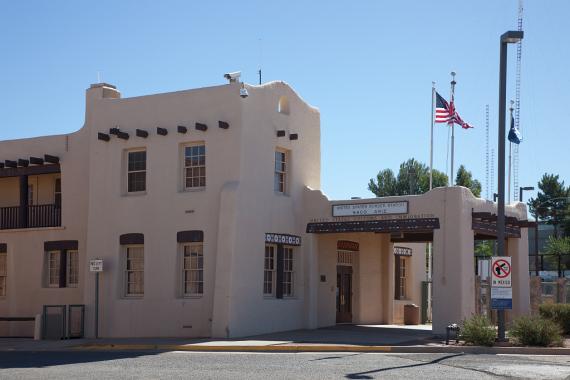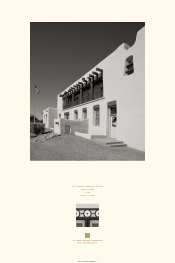U.S. Border Inspection Stations, United States
History
U.S. Border Inspection Stations built between 1931 and 1943 were new building types planned, designed and constructed by the U.S. government in response to greatly increased volume of motor vehicles across land borders, and the need to adequately enforce the nation's new customs and immigration laws. Prior to the 1920s, goods and people primarily entered the United States at sea, lake or river ports.
As motor vehicle ownership, popularity, and total miles traveled increased, the U.S. Bureau of Public Roads improved roads and highways at international borders with Canada and Mexico. In 1917 and 1921, immigration laws were tightened, and the imposition of head taxes and quotas resulted in increasing numbers of illegal border crossings. From 1919 through the 1920s, prohibition laws increased the smuggling of alcohol and other illegal goods across land borders.
Legislation passed on June 25, 1910, authorized the construction of the border stations. The 1928 Congressional report by H. A. Benner of the Bureau of Customs and J. L. Hughes of the Bureau of Immigration spearheaded the construction of purpose-built border stations at forty-eight land crossings. The report highlighted how the non purpose-built customs and immigrations facilities, which included space rented from private entities or occasionally train cars and tents, were obsolete. It then recommended that the new stations be government owned; demonstrate federal authority and presence; have proper location, proper facilities, dignified and attractive surroundings, fair and adequate service to the public; and possess decent living quarters for customs and immigration officials posted at remote locations.
Border Inspection Station funding was approved under the Public Buildings Act of 1926 that allocated $165 million for federal building construction across the country. The Supervising Architect of the Treasury, first James A. Wetmore (1915-1933) and later Louis A. Simon (1933-1939), prepared standardized designs generally of three, five, or seven or greater bays. Many of the historic border stations were constructed through President Roosevelt's Public Works Administration (PWA) employment and economic recovery program. In 1943, the last of the purpose-built border stations from this era was completed in Laredo, Texas.
Architecture
The U.S. Border Inspection Stations from 1931-1943 were a newly invented, modern building type designed in response to the advent of the automobile. Usually located along the highway as one crossed the international border, U.S. Border Inspection Stations were often the first buildings encountered when entering the United States by road.
The buildings are one- to two-story, rectangular plan, wood-frame constructions. The majority feature orthogonal facades with an orderly arrangement of large, multi-light wood frame windows flanking centered entrances beneath centered, affixed porte-cocheres. Many of the border stations are symmetrically flanked by hipped roof multi-bay garage wings. Though referencing the Colonial Revival style, such features also provided "proper facilities" for vehicle inspection. Large windows allowed for easy viewing of incoming vehicles, and the porte-cocheres provided protection from the elements during the inspection process. Customs and Immigration officials used one garage wing for their vehicles, and used the other, which often included a sub-level pit, for inspection purposes and retaining confiscated vehicles. The centered entrance leads to a shared lobby with symmetrically placed counters on either side, for Customs and Immigration services. This arrangement was intentionally designed for expedient, "fair and adequate service to the public."
The use of revival styles for historic Border Inspection Stations conveyed a federal presence and United States-specific imagery associated with the country's earliest Americans. Though a version of Georgian Revival, referencing the buildings of the early American Colonists is often applied, Spanish Colonial Revival and Pueblo Revival, which reference the first European settlers and early Native Americans in the southwest, are often employed in that region. The Log Cabin style is used in northern mountain region states, referencing dwellings built by westward explorers 130 years earlier. Common cladding materials include American bond brickwork or wood clapboard, with stucco in the southwest. Above the large windows are often gauge brick jack-arched lintels with centered, decorative keystones. Original entries have multi-paneled wood doors with upper portion multi-light sash, and are often topped with transom windows. Ornamental porte-cocheres with balustrades and classically detailed columns are sometimes present. Roof types, either side gabled, hipped, or gambrel, reference the American, British, and Dutch versions of Colonial Revival respectively. In colder climates, a steep pitch side gabled roof is often incorporated to shed snow.
Inside, ground floors are usually symmetrical in arrangement, with Customs and Immigration offices behind patterned privacy glass topped by operable transom windows with brass hardware. Orange Fireflash floor tile is common in lobbies as are original display cases. Stairways with natural wood handrailing and column-like balusters are common. Upstairs, some border stations possess detention rooms with metal doors and others have sleeping quarters for officers, or meeting rooms. Pairs of standalone, single-family residences are present in certain remote locations. Often designed in the Cape-Cod style, the houses are square plan and one story with wood clapboard cladding, occasionally with a fanlight window at the side gable. Other auxiliary structures include cattle inspection pens, standalone garages, and truck inspection facilities.
Many border inspection stations possess original landscaping of lawns, small shrubs, and a prominent standalone flagpole. Near the lobby entrance most border stations have a cornerstone plaque listing the year of construction and the supervising architect of the Treasury at the time. Common alterations include window, cladding, or porte-cochere replacement, and the removal of standalone houses. However, most extant border inspection stations from 1931 to 1943 retain many of their original features.
Significant Events
- 1919-1933: Prohibition, increased auto usage, and tighter immigration laws make pre-existing border station facilities obsolete
- May 25, 1926: Public Buildings Act allocates $165 million to fund construction of new federal buildings, including border stations
- March 13, 1928: Benner & Hughes Congressional Report articulates key ideas to inform new border stations
- February 5, 1930: Earliest known blueprint for a purpose-built border station at a land crossing (San Luis, Arizona)
- 1943: Laredo, Texas, border station, the last of the purpose-built border stations from 1931-1943, completed
Facts
- Architect: Simon, Louis A.; Neal A. Melick; Office of the Supervising Architect of the U.S. Treasury
- Architectural Styles: Georgian Colonial Revival; Spanish Colonial Revival; Pueblo Revival; Log Cabin
- Construction Dates: 1931-1943
- Location: Mexico and Canada land borders
- Landmark Status: Listed in the National Register of Historic Places
- Primary Materials: American bond brickwork; Wood clapboard cladding; Stucco
- Prominent Features: Biaxial symmetry; Affixed garage wings and porte-cocheres; Located at international border highways; Region-specific design themes
Poster Download
Download the poster [PDF - 226 KB]

 U.S. General Services Administration
U.S. General Services Administration

